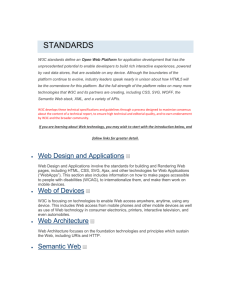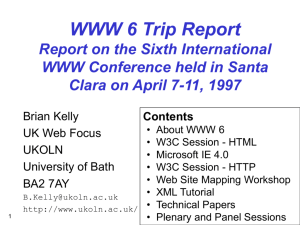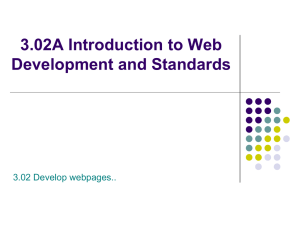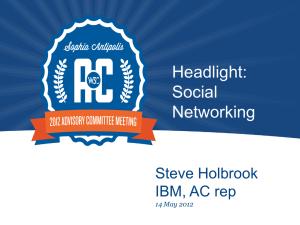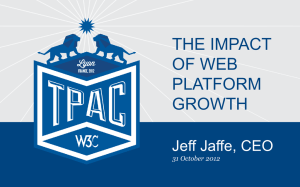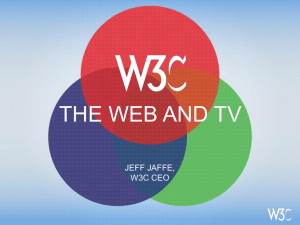eLib Technical Issues Concertation Day
advertisement
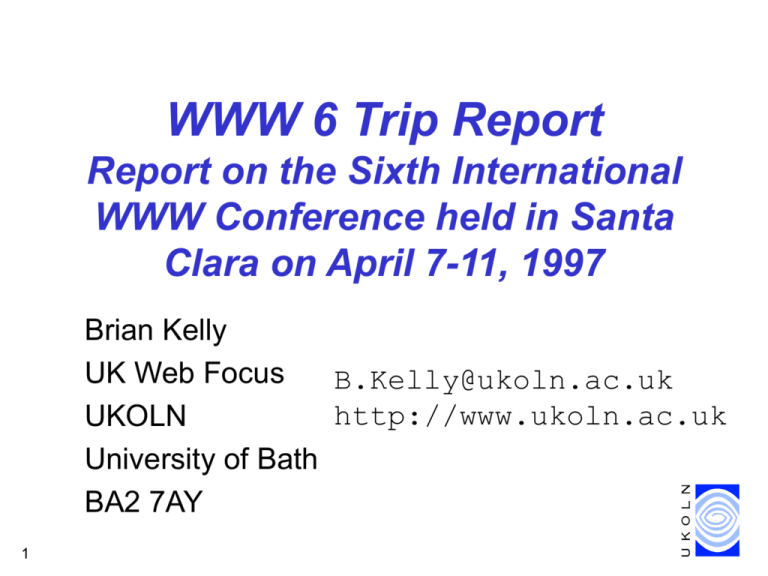
WWW 6 Trip Report
Report on the Sixth International
WWW Conference held in Santa
Clara on April 7-11, 1997
Brian Kelly
UK Web Focus
B.Kelly@ukoln.ac.uk
http://www.ukoln.ac.uk
UKOLN
University of Bath
BA2 7AY
1
UK Web Focus
UK Web Focus is:
• A JISC funded initiative
• Based at UKOLN, University of Bath
• Involved in various WWW activities:
– Technology watch
– Information dissemination throughout UK
HE community
– Coordination of WWW activities
– Represents JISC on W3C
Brian Kelly appointed as UK Web Focus on
1st November 1996
2
About WWW 6
WWW 6:
• Held at the Santa Clara Convention Centre
• Workshops and tutorial sessions on
Monday 7th April
• Technical papers from 8-10th April
• Developer's Day and History Day on 11th
April
• Various other BOFs and meeting (including
Web Accessibility Initiative day
3
Before the Conference
• Conference details
including online booking
available on Web-
http://ice.www6conf.org/
http://www6conf.org/
• Online conference (ICE)
available for delegates
before, during and after
conference
• Conference proceedings
available online
http://proceedings
.www6conf.org/
4
ICE
ICE (Interactive Conference Environment):
• A new facility for WWW conferences
• Provided a home page and messaging facilities
for delegates
• Providing online registration for conference
events
Usefulness:
• General conferences not widely used (eg. Web
site design) but specific conferences were (travel
tips, social events)
• Usability could be improved
5
WAI Day
Web Accessibility Initiative (WAI) day:
• Held on Sunday 6th April
• About 80 participants
• Morning consisted of presentations including:
– US Government support for Initiative (Thomas
Kalil, White House) and National Science
Foundation involvement
– Details of the W3C WAI - has been agreed by W3C
members (Jim Miller, W3C)
– Other presentations from Kate Seelman (NIDRR),
Mike Pacielli (YRIF), Tim Berners-Le (W3C), Peter
Bosh (RNIB), Gregg Vanderheiden (Trace
Research), Michael Sfyrakis (ICS-Forth) and
Murray Maloney (SoftQuad)
6
"Opening Windows or
Closing Doors"
Peter Bosher (RNIB,
UK) spoke about the
tremendous benefits of
IT for the visually
impaired, but also the
pitfalls that blind people
face. e.g.
• Times job vacancies
page is usable with Lynx
and speech browsers
• London Broadcasting
Company pages are poor http://www.lbc.co.uk/
7
Want "cool with content"
"Opening Windows or Closing
Doors" (2)
Other comments Peter made:
• Poorly designed navigation (when you follow
several links, and then get back to where you
started) is a particular problem for the blind who
don't have the visual clues that the sighted have
• When navigating the Hotwired site his browser
said "link link link link image image image without
caption"
• Tables are difficult to process by speech browsers
• Painstakingly competing a form and then getting
an error message because the form was browser
specific is annoying
8
WAI - Afternoon Session
In the afternoon presentations were given from
speakers from Sun and Microsoft.
T.V. Raman (Adobe) spoke about the benefits
of "smart documents" - in which the paper
document is just one form of rendering. He
spoke about the audio cascading style sheet
proposal.
Following a panel session the day concluded
with breakout sessions on:
9
• Technology issues
• Development of Guidelines
• Educational Issues
Further Information
Further information on the Web Accessibility
Initiative, and on general accessibility resources
is available at:
http://www.w3.org/pub/WWW/Disabilities/
http://weber.u.washington.edu/~doit/
Other/design.html
http://www.igs.net/~starling/acces.htm
http://trace.wisc.edu/
http://access.adobe.com/
http://cs.cornell.edu/home/raman/
10
Web Collections Workshop
Half day workshops on web collections:
• Defining relationships between groups of related
documents
• Useful for:
– printing
– off-line browsing
– indexing
• Presentations on:
– Protocols (Web Collections, MCF, Dublin Core)
– Applications (HotSauce, WebCutter,
WebMapper)
11
Day 0 - 9 am
Conclusions
The Web Site Mapping workshop agreed:
12
• Split protocol into three:
– Metadata Model
– File Format Syntax
– Metadata Manipulation Language
• Further discussions needed on:
– Whether a new query language is needed (e.g.
SQL, HyTime Query Language)
– Whether we need a metadata query language
or a general document query language
– A list of common site mapping operations, to
help define an API
• XML is likely to be the preferred syntax
XML Tutorial
XML:
•
•
•
•
•
•
Extensible markup language
An SGML-lite designed for the Internet
Developed by the SGML community
Tools being developed by SGML tool vendors
Microsoft involvement
Two XML draft specs:
English
– XML
French
– XML-link A richer form of linking
• Stricter than HTML (to reduce client processing):
– Attribute quoting <IMG SRC="logo.gif">
– End tags needed <P>A paragraph</P>
13
Day 0 - 2 pm
Opening Speeches
Introduction from Gerhard Casper, President
of Stanford University
• Delegates from forty countries attended WWW 6,
50% academic and 50% commercial.
• Overall attendance not known at start of
conference. Believed to be about 1,800 - this
was down on expectations, perhaps due to the
JavaOne (8,000) and Microsoft Hardware
Developers conference (15,000) held in San
Francisco the previous week.
14
Day 1 - 9 am
Opening Speeches
Dr Mae Jemison
• Mae Jemison, who was an astronaut on
Endeavour, spoke on the social responsibilities of
technologists
Thomas Kalil
• Thomas Kalil, Director of the National Economic
Council, spoke on US government initiatives to:
– Connect people with disabiliities to Web
– Connect every student to Web (see
http://netday.org/)
– Connect people in Africa to Web
• He repeated comments he made in the WAI day
15
Day 1 - 9 am
"Beyond HTML"
The technical session on "Beyond HTML"
16
• Took place at 11 am on Tuesday, 8th April
• Papers presented on:
– "Bookmarking Service for Organizing and
Sharing URLs" by Richard M. Keller et al
– "Extending HTML in a Principled Way with
Displets" by Fabio Vitali et al
– "Index-Based Hyperlinks" by John H.
Hartman, Todd A. Proebsting, Rajesh
Sundaram
– "Metadata Mediation : Representation and
Protocol" by Tsuyoshi Sakata, Hiroyuki Tada,
Tomohisa Ohtake
Day 1 - 11am
Bookmarking Service for
Organizing and Sharing URLs
This paper outlined
limitations in bookmarking
(monolithic structure,
problems in sharing URLs,
ranking long lists and
navigation).
WebTagger uses a proxy
service which adds buttons
at top of pages. These can
be use to provide a richer
bookmaking service.
See http://www6.nttlabs.com/
HyperNews/get/PAPER189.html
17
Day 1 - 11am
Extending HTML in a
Principled Way with Displets
This paper describes a Java solution to adding
new tags to HTML.
<TAG NAME=CHART ..
SRC=chart.class>…</TAG>
<CHART TYPE=BAR>
<TABLE>
<TH> JAN/<TR><TH>125…
</TABLE>
</CHART>
HTML source
18
Jan
Jan
Smith 125
Green 137
Apr
Apr
257
140
Jul
Oct
Jul
327
110
Oct
250
160
HTML output
Day 1 - 11am
Extending HTML in a
Principled Way with Displets
Other extensions:
Multi-way links
Graphs
Reference information
Tutorial
OK
For further information
Cancel
Issues:
How does this fit in with XML?
How does this fit in with the HTML Math work, which
proposes using Java to display Maths output?
Further Information:
19
http://proceedings.www6conf.org/
HyperNews/get/PAPER155.html
http://pegasus.rutgers.edu/
~chchiu/displets.html
Day 1 - 11am
Index-Based Hyperlinks
Problem:
• Web pages have too many links for authors
to manage
• Web pages have too few links for readers
(e.g. a language student may want every
word to be a link - an author would not want
to maintain such a document)
• Only one URL per link allows
• The URL name provides little meaning
• Link can only be created by the author
20
Day 1 - 11am
Index-Based Hyperlinks
Possible solutions include:
• Automatic generation of links
(can be inaccurate)
• Use Javascript (heavy weight)
In Index-based Hyperlinks:
• Indices associate attributes with
phrases
• Browsers can implement the
linking policy (i.e. link on first
occurrence of phrase)
• Indexes are separate from
document
• Prototype in HotJava
21
Day 1 - 11am
Index-Based Hyperlinks
Further Information
http://www6.nttlabs.com/
HyperNews/get/PAPER248.html
http://www.cs.arizona.edu/sumatra/
22
Day 1 - 11am
"Leading the
Evolution of HTML"
W3C Session
This W3C session:
• Took place at 2 pm on Tuesday, 8th April
• Talks by Dave Raggett, Arnaud LeHors and Rob
Miner
• Covered:
HTML developments
Metadata
XML
Maths
• Technical discussion on HTML takes place on
www-html list.
• Feedback should be sent to www-htmleditor@w3.org
23
Day 1 - 2pm
W3C Session
HTML Developments
Cougar:
• Code name for next version of HTML
• Needed as "forces driving evolution of HTML are
threatening media independence"
• First draft available summer 97
• Some parts already released:
WD-htmllink
WD-script
WD-frames
WD-forms
WD-object
WD-entities
WD-fileupload
• See http://www.w3.org/pub/WWW/
MarkUp/Cougar/
24
Day 1 - 2pm
W3C Session
WD-htmllink
WD-htmllink
• Hypertext links in HTML.
• Defines link relationships (e.g. <LINK REL=Next>
could be used to facilitate printing in a single
document split into several files)
• Related to Style Sheet work
<LINK REL=Stylesheet MEDIA=print
HREF=ukoln-print.css>
• Define TITLE attribute for hints for accessibility e.g.
<A HREF="welcome.html" TITLE="The
Welcome page for ACME Ltd">text</A>
In this example a browser could display the text in,
say, a pop-up window.
25
Day 1 - 2pm
W3C Session
WD-htmllink
WD-htmllink (continued)
• Defines uses of META tag (e.g. for use with PICS)
• Define language(s) for documents
• Define pages which can be indexed by robots
<META NAME="ROBOTS"
CONTENT="NOINDEX, NOFOLLOW">
prohibits robots from indexing and
following links
26
Day 1 - 2pm
W3C Session
WD-style
WD-style
• HTML and Style Sheets
• Defines relationships between HTML document
and stylesheet
• Single style sheet can be defined by:
<LINK REL=stylesheet HREF="corporate.css">
• Cascading style sheets can be defined by:
<LINK REL=stylesheet HREF="corporate.css">
<LINK REL=stylesheet HREF="techreport.css">
• Can define alternate style sheets for media types:
<LINK REL=stylesheet MEDIA=screen …>
• MEDIA types can include Print, Screen, Aural,
Braille,...
27
Day 1 - 2pm
W3C Session
WD-script
WD-script
• Client-side Scripting and HTML
• Defines mechanism for embedding scripting
languages in HTML:
<SCRIPT type="text/javascript">
document.write ("<EM>This will work</EM>")
</SCRIPT>
• <SCRIPT SRC="url"> used for external scripts
• Default script language can be defined: <META
HTTP-EQUIV="Content-Script-Type"
CONTENT="text/tcl">
28
Day 1 - 2pm
W3C Session
WD-script
WD-script (continued)
• Self-modifying documents and event
handlers can be written
<SCRIPT TYPE="text/vbscript">
Sub edit1_changed()
If edit1.value = "abc" Then
button1.enabled = True
Else
button1.enabled = False
End If
End Sub
</SCRIPT>
• Events include onLoad, onClick, MouseOver,
onSelect, ...
29
Day 1 - 2pm
W3C Session
WD-frames
WD-frames
• Defines existing usage of FRAME tag
• Includes IFRAME proposal for inclusion of frames
inline in body of HTML documents (FRAME tag
replaces BODY tag):
<BODY>
<P>This document contains an inline frame
<IFRAME src="foo.html" width=400 height=500>
that unfortunately your user agent doesn't
support. Alternatively you can get the
related document <A href="foo.html">here
</A>.</IFRAME> That's all folks!
</BODY>
30
• Initial release of FRAMES caused problems, and
there are still accessibility concerns
Day 1 - 2pm
W3C Session
Dynamic HTML
• Based on work of the Document Object
Model (DOM) working group
• Provides an API (applications programming
interface) for HTML page structure and style
• Microsoft's Internet Explorer 4.0 implements
many features of Dynamic HTML
31
Day 1 - 2pm
W3C Session
XML
XML:
• Is a clean subset of SGML
• It is felt that XML and HTML will coexist for
some time
• Further information on XML is given
elsewhere in this presentation
32
Day 1 - 2pm
W3C Session
IETF and ISO and HTML
IETF are working on various aspects
associated with HTML
• MHTML (email encapsulation of HTML)
• WEBDAV (The Web Distributed Authoring
and Versioning working group)
ISO
• The ISO/JTC1/SC18 work on HTML 3.2
33
Day 1 - 2pm
W3C Session
HTML Math
The HTML Math spec:
•
•
•
•
34
Is due out in May 97
Core standard covering presentation and markup
Will contain 20 presentation tags with 40 attributes
Will contain 50 content tags (roughly equivalent to
functions on scientific calculator)
• Initially will be implemented using embedded
elements (ActiveX, Java) enabling 3rd parties to
develop the rendering tools (won't need to wait for
Netscape or Microsoft)
• Software will be available in June 97
• Full implementation requires better browser APIs
(e.g. DOM)
Day 1 - 2pm
W3C Session
CSS
The CSS1 (Cascading Style Sheet) spec:
•
•
•
•
Replaces all HTML extensions
Can replace most uses of tables
Provides floating text elements
Provides control over background
History:
Sept 94 - Initial CSS proposal
June 96 - MS IE 3 released supporting CSS
Dec 96 - CSS1 draft finished
CSS logo available for pages using style sheets (see
http://www.w3.org/pub/WWW/Style/CSS/
Buttons/Menu/
35
Day 1 - 2.45pm
W3C Session
CSS
Q
How closely matched are the CSS and XML?
A
Q
They are a good match
Features such as side bars (e.g. <P
CLASS=side>) are likely to be widely used.
Should such attributes be registered?
It's likely that a set of standard style sheet
definitions will be released, and they'll be widely
used
Will CSS held to reduce network bandwidth?
Yes, see
http://www.w3.org/pub/WWW/Protocols/
NL-PerfNote.html
A
Q
A
36
Q
A
What about headers and footers?
In next release
Day 1 - 2.45pm
W3C Session
CSS - The Next Wave
In next version of CSS:
• Multiple media (using @media)
• Improved printing support (headers, footers,
margins, etc.)
• Better control over positioning (e.g. out-of-flow
elements, navigational bars, layering)
• Better font control (mixed fonts - e.g. helvetica and
cyrillic for, say, language dictionaries)
• Aural cascading style sheets (as well as for
visually impaired also for in car-use, industrial and
medical systems, entertainment, illiterate):
37
– <STRONG> rendered as loud voice, pause-before
– Left column in table spoken in left speaker
Day 1 - 2.45pm
"Multidimensional Web
Search"
The technical session on "Multidimensional
Web Search"
• Took place at 4 pm on Tuesday, 8th April
• Papers presented on:
– "Towards a Multimedia World-Wide Web
Information Retrieval Engine" by
Sougata Mukherjea et al
– "Dynamic Reference Sifting: A Case Study
in the Homepage Domain" by Jonathan
Shakes et al
– "ParaSite: Mining Structural Information on
the Web" by Ellen Spertus
38
Day 1 - 4 pm
Towards a Multimedia World-Wide Web
Information Retrieval Engine (1)
Paper that integrates
searching for text with
searching for images.
• Search for "baseball player"
• Select one of the images
retrieved, and search for
others similar to this one
• Give schematic drawing (as
shown)
• Provide 3D visualisation of
search results using VRML
39
Find an image that
looks like this will find
Mickey Mouse from
the Disney Web site
Day 1 - 4 pm
Towards a Multimedia World-Wide
Web Information Retrieval Engine (2)
The software is called
AMORE.
Prototype available at
http://www.ccrl.
neclab.com/amore/
See
http://www6.nttlabs.
com/HyperNews/
get/PAPER3.html
40
Day 1 - 4 pm
Dynamic Reference Sifting:
A Case Study
Described Ahoy! - a
Web application used
for finding personal
home pages based
on recognition of
likely hits from
directory naming
conventions.
See
http://www6.nttlabs.com/
HyperNews/get/PAPER39.html
41
http://www.cs.washington.edu/research/ahoy
Day 1 - 4 pm
Parasite: Mining Structural
Information on the Web
Based on heuristic assumptions including:
Hypertext Linking
• A linked page is likely to be on the same topic as
the original page (esp. for Yahoo type resources)
Directory Structure
• A URL containing a directory below a personal
home page (PHP) is likely to be authored by the
person identified in the PHP
Page Structure
• Links "near" each other on a page are likely to
have similar topics
42
Day 1 - 4 pm
Parasite: Mining Structural
Information on the Web
Used these assumptions to propose
applications for finding:
• moved pages
• related pages
• people
Comments
• Brute strength approach
• This and preceding paper (on Ahoy!) show
importance of directory naming conventions
(directory names provide metadata - what
can we guess from the URL
www.cs.acme.edu/staff/jsmith)
43
Day 1 - 4 pm
Plenary Session
All Authored Works Online: A Global
Infrastructure for Universal Access to
Information
Raj Reddy, Dean of the School of Computer Science
at Carnegie Mellon spoke on the Universal Library
project - when "All Authored Works of the Human
Race will be available to anyone in the world
instantaneously".
His talk is available at
http://www.ul.cs.cmu.edu/rr/aaw/aaw.html
Accessibility of Everything
Michael Dertouzos ...
44
Day 2 - 9 am
MBONE Link With Germany
Dave Ingham (Computer Science,
Newcastle University) was asked to deliver
his paper (on Supporting Highly
Manageable Web Services) to the
Conference in High Energy Physics using
the MBONE
45
Day 2 - 10.30 am
Good Web Design
Good Web Design Panel Session
• A very popular session on Web design
• Panelists included Jakob Neilson (Sun),
David Seigel (a leading web designer and
author of the 1 bit clear GIF used to provide
spacing), Cathy Gill (HTML Writer's Guild)
and others
• Strong disagreements between the design
community (David Seigel) and the
structuralist community (Jakon Neilson)
• I attended the start and end of this session
46
Day 2 - 2 pm
Good Web Design
What is Good Design?
47
• No frames - Jakob Neilson's response (see his
paper on 10 top mistakes in web design)
• The design must be related to a user's tasks
• A well-designed site downloads quickly
• A good design doesn't break browsers
• No gratuitous backgrounds or animation
• Should be internally consistent
• Should be externally consistent in use of navigation
(Jakob Neilson's comments on need for standard
navigational aids such as not changing colours of
hypertext links)
• Variety in navigational aids (David Siegel's
Day 2 - 2 pm
response)
Good Web Design
Other Comments
• "Designers shouldn't be used as shields in the
browser wars"
• Web sites need (automated) feedback
mechanisms
• There aren't enough good web designers, so we
need guidelines
• We need good example of web design (and
commentary on the design)
• See Highfive (David Seigel) - http://www.highfive.com/
• See http://eunisis.com/resources/??
48
• See ACM/Interactions (May/June 97) for a critique
of Web design
Day 2 - 2 pm
Bad Web Design?
There was much
disagreement over the
Seigel "hack" illustrated
49
image4.gif
• Image on the next page
stored in a 1 pixel by 1 pixel
• The image is downloaded
<IMG SRC=image5.gif
while main image is being
height=1 width=1>
examined
• Moving to the next image it
appears to load quickly
• "Neat trick" - David Seigel
• "Hack", "future maintenance
problems" "no semantics"
Site Mapping and
Syntactic Analysis
The technical session on "Site Mapping
and Syntactic Analysis"
• Took place at 2 pm on Wednesday, 9th April
• Papers presented on:
– "Finding Salient Features for Personal
Web Page Categories" by
Marilyn R. Wulfekuhler, William F. Punch
– "Syntactic Clustering of the Web" by
Andrei Z. Broder et al
– "Analysis and Design of Web-based
Information Systems" by Takahashi and
Liang
50
Day 2 - 2 pm
Syntactic Clustering of the
Web
51
Award winning paper
Using a clustering algorithm to find "similar" documents
Can be used to:
• In response to a 404 not found message, find
similar versions of a resource
• Observe how resources change over time (find
new and out-of -date versions)
• Find plagiarisms
Results
Tested on 30,000,000 documents in Alta Vista
60% of documents are unique
Most clusters of similar documents are small
Day 2 - 2 pm
Microsoft IE 4.0
Presentation in the Industrial Presentations track on
Internet Explorer's implementation of Dynamic HTML
52
HTML is limited:
• Animation using animated GIFs is limited
• Can't position or layer elements
• The web is slow - interaction with server needed
Dynamic HTML:
• Based on emerging W3C proposals
• Covers:
– Dynamic styles and dynamic contents
– CSS positioning - Data binding
• See http://www.microsoft.com/workshop/
prog/aplatfrm/dynhtml-f.htm
Day 2 - 4 pm
Microsoft IE 4.0
Dynamic HTML
• Positioning control (in
X, Y and Z planes)
• Position can be
changed at run time
(e.g. on mouseOver
event)
53
Day 2 - 4 pm
Microsoft IE 4.0
Dynamic Style Sheets
CSS properties can be changed at run time:
<H1 onMouseOver {color: red;}
onMouseOut {color: yellow;}>
A more elegant way is to store the Javascript
code in the document HEAD (or externally)
CSS Positioning
Elements can be positioned absolutely or relative to
each other
<IMG SRC="smiley.gif" : top: 25% ; zindex=1>
<DIV zindex =2>Text on top of image</DIV>
54
Text on top of image
Day 2 - 4 pm
Microsoft IE 4.0
Dynamic Content
The Document Object Model (DOM) can be
used to change the content at runtime:
function change() "new header"
...
<H1 id=foo onclick=change()>Old Header</H1>
For example a table of contents could be built
dynamically
55
Day 2 - 4 pm
Microsoft IE 4.0
Data Binding
Currently data binding
(merged data from
database with HTML
code) is done on the
server
Data binding proposal
enables it to be done on
the client so that, for
example, the output
from a search engine
can be resorted on the
client)
56
http://www.microsoft.com/ie/
ie40/browser/bestweb/
Day 2 - 4 pm
Microsoft IE 4.0
Dynamic HTML
Multimedia Effects
57
Uses IE4 control to provide
multimedia effects
Removes need for animated
GIF
Variety of effects available:
• Transitions, filters,
structured graphics,
sequencing
• sprite control (scripted
animated GIFs)
• Example - e rotating in
3D
How will Powerpoint be
marketed if this is
possible in HTML?
Day 2 - 4 pm
Microsoft IE 4.0
Document Object Model (DOM)
• DOM enables every HTML element to be
processed as an object (i.e. DOM is an API for
accessing HTML elements)
• DOM is not a
set of tags or a
new language
(it is language
independent)
58
Day 2 - 4 pm
Microsoft IE 4.0
Standards
• IE 4.0 conforms to HTML 3.2 and CSS1
• Implements new W3C drafts (e.g. DOM, forms)
• Javascript is being standardised by ECMA
Support for legacy browsers?
• Don't use new features
• New features degrade gracefully
• New features won't work (e.g. Tetris example 10K HTML file, which used no ActiveX controls)
Security
59
• Based on domains (pages from one domain can't
read pages from other domains)
Day 2 - 4 pm
Plenary Session
Yuri Rubinsky Memorial WWW Award
• Murray Mahloney presented the award to
Gregg Vanderheiden for his involvement with
disability work
• Apple and Microsoft have been strongly
influenced by the work of the TRACE centre
The Social Web
• Howard Rheingold, author of Virtual
Communities and execuitve editor of Hot
Wired spoke about the collaborative Web
• "Convergence sucks!" The Web shouldn't be
like the TV, it should be like the phone.
• See Electric Minds at
http://www.minds.com/
60
Day 3 - 9 am
Plenary Session
MBONE Session With Hypertext 97
A live panel discussion using video link
Robert Cailliau (CERN), Terry Winograd
(Stanford), Ora Goldstein (HP) and Howard
Rheingold from WWW 6 conference
Wendy Hall (Southanpton Univ), ??? Electronic
Telegraph, Cathy Marshall (Xerox) and Ted
Nelson from Hypertext 97 conference
61
Day 3 - 9 am
Plenary Session
Panelists discussed question "Why both with research?
Let's leave the web to the marketplace"
Robert Cailliau - "The original NeXT browser
provided collaborative authoring. This still hasn't
been implemented by commercial browsers. As
will be seen a the History Day there have been
many research prototypes which haven't yet been
implemented commercially. The question should
be 'Can the commercial world keep up with the
research community?' The commercial world has
brought us frames, but the worthy research
prototypes from 1990 have been lost"
62
Plenary Session
63
??, Electronic Telegraph: Commercial products can't
be expected to keep up with research
developments. Carry on researching.
Terry Vinograd: Researchers are carrying out
valuable exploratory design work - design
something, make it available and see if it flies.
Howard Rheingold: There is a need to legitimise
social science research
Ted Nelson: The hypertext community's view of the
Web is "Where did we go wrong!" The Web
community is failing to look at the history of
hypertext, standardisation (cf. the browser wars),
etc. We need a stable reusable Web which
facilitates long term use.
Automatic Interface Generation
The technical session on "Automatic Interface
Generation"
• Took place at 4 pm on Thursday, 10th April
• Papers presented on:
– "Transforming Command-Line Driven Systems to
Web Applications" by Phanouriou and Abrams
– "Responsive Interaction for a Large Web
Application The Meteor Shower Architecture in the
WebWriter II Editor" by Crespo et al
– "The Message Is the Medium" by Seligmann et al
– "Seamless Integration of Interactive Forms into the
Web" by Girgensohn and Lee
64
Day 3 - 2 pm
Transforming Command-Line Driven
Systems to Web Applications
This paper described work which used Java
to provide access to a legacy command line
application (a monolithic Fortran 77
program) on the Web:
• Input to application
via Java form
• Output in Java
applet window
• Commercial product
available soon
65
Day 3 - 2 pm
Responsive Interaction for a Large Web Application
The Meteor Shower Architecture in the WebWriter II
Editor
An HTML authoring
tool with server and
client side
processing.
Makes use of
frames.
Uses <BLINK> to
define flashing
cursor
66
http://www6.nttlabs.com/
HyperNews/get/PAPER86.html
Day 3 - 2 pm
The Message Is the
Medium
This paper described a
number of approaches
to using visual imagery
in Web interfaces.
The user interfaces
can be accessed in
the Metaphorium
which is available at
http://www.multimedia.
bell-labs.com/
Metaphorium/
67
Seamless Integration of
Interactive Forms into the Web
This paper described
limitations of existing
forms on the Web and
described how Dynamic
Forms would overcome
these limitations.
Dynamic Forms is based
on Java.
But what about W3C work
on HTML (new DOM and
Forms specs)?
68
http://www6.nttlabs.com/
HyperNews/get/PAPER83.html
Strategies for Resource
Location
The technical session on "Strategies for
Resource Location"
• Took place at 4 pm on Thursday, 10th April
• Papers presented on:
– "SiteHelper: A Localized Agent that Helps
Incremental Exploration of the World Wide
Web" by Ngu and Wu
– "WebQuery: Searching and Visualizing the
Web through Connectivity" by Carrière and
Kazman
– "WebCutter: A System for Dynamic and
Tailorable Site Mapping" by Maarek et al
69
Day 3 - 2 pm
WebQuery
Paper on various
visualisation
techniques for
searching.
Based on structural
information to find "hot
spots"
70
http://www6.nttlabs.com/HyperNews/
get/PAPER96.html
Day 3 - 2 pm
WebCutter: A System for Dynamic
and Tailorable Site Mapping
Paper on IBM/Lotus
product for website
visualisation
• Implemented in Java
• Map generated on
the fly
• Map can be edited
by end user (to
define user's view of
web site)
http://www6.nttlabs.com/HyperNews/
get/PAPER40.html
71
Day 3 - 2 pm
Closing Session
• John Gage, Sun, gave a talk on
Java
• Gregg Vanderheiden spoke on the
importance of accessibility issues
• Bob Metcalfe gave an entertaining
speech. Two years ago he predicted
the collapse of the Internet.
Conceding that it hadn’t collapsed,
he literally ate his words.
72
Day 3 - 2 pm
Closing Session
Robert Cailliau awarded the prizes
73
Best Tutorial
Steve Lewontin - Doing things With The
Web: Where Application Execute
Best Paper
Andrei Brider et al - Syntactic Clustering of
the Web
Runner-up
Jonathon Shakes et al - Dynamic
Reference Sifting: A Case Study in
Homepage Domain
Day 3 - 2 pm
Developer's Day Opening
Opened with wakeup call by Ted Nelson
(video link)
"Those who fail to study history are doomed to
repeat it" - theme of Ted's talk (and the History
Day).
He concluded by saying:
"my past is your future"
Tim Berners-Lee then reviewed developments
of the Web and outlined the road ahead.
74
Day 4 - 9 am
Developer's Day - HTTP
Transparent Content Negotiation (TCN)
• IETF draft
• Enables:
– Deployment of new data formats and tags
– Tailoring of content for new platforms
– Internationalisation
• See ftp://ftp.ietf.org/internet-drafts
/draft-ietf-http-negotiation-01.txt
• TCN spec server sends list of variants:
<IMG SRC="logo">
HTML source
{logo.gif
{logo.png
type image.png}
type image.png}
Variant list sent by server
75
Day 4 - 9 am
Developer's Day - HTTP
Feature Negotiation
• IETF draft
• Part of TCN, addressing extensibility
• No more "Click here from frames, here for
tables" buttons
• Universal agreement on new features not
needed
• See ftp://ftp.ietf.org/internetdrafts/draft-ietf-http-featurereg-00.txt
76
Day 4 - 9 am
Developer's Day - XML
• Report on XML workshop given by Eve
Maher.
• Discussed "Where to from here?"
77
Day 4 - 2 pm
WWW 6 - The Good Points
Some of the good things about WWW 6 were:
• Use of the Web to support the conference (online
registration, conferencing system, proceedings,
etc.)
• High profile for accessibility issues
• W3C sessions on web protocol developments
• Meeting old and new faces
78
WWW 6 - The Bad Points
Some of the failings of WWW 6 were:
• Local organisation:
– Catering (lack of coffee in afternoon, lunches)
– Failure to notify session chairs before conference
– Technical support in sessions (e.g. sound quality)
– Evaluation form
– Lack of list of delegates
• Numbers of participants was down on last year
• Lack of standardisation of presentations
(compared with WWW5)
• Presentations not being made available on WWW
79
Conclusions
• Conferencing system such as ICE should
be provided for future WWW conferences
• Accessibility is important
80
